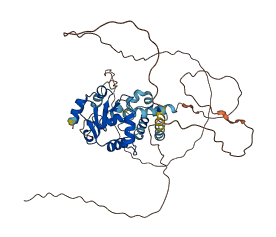P13474
Gene name |
ETS1 |
Protein name |
Transforming protein p54/c-ets-1 |
Names |
|
Species |
Gallus gallus (Chicken) |
KEGG Pathway |
gga:396235 |
EC number |
|
Protein Class |
|

Descriptions
Autoinhibitory domains (AIDs)
Target domain |
331-415 (ETS domain) |
Relief mechanism |
Partner binding |
Assay |
|
Target domain |
331-415 (ETS domain) |
Relief mechanism |
Partner binding |
Assay |
|
Accessory elements
No accessory elements
References
- Yeon JH et al. (2016) "Systems-wide Identification of cis-Regulatory Elements in Proteins", Cell systems, 2, 89-100
- Garvie CW et al. (2002) "Structural analysis of the autoinhibition of Ets-1 and its role in protein partnerships", The Journal of biological chemistry, 277, 45529-36
- Nelson ML et al. (2010) "Ras signaling requires dynamic properties of Ets1 for phosphorylation-enhanced binding to coactivator CBP", Proceedings of the National Academy of Sciences of the United States of America, 107, 10026-31
- Ning S et al. (2022) "The auto-inhibition mechanism of transcription factor Ets-1 induced by phosphorylation on the intrinsically disordered region", Computational and structural biotechnology journal, 20, 1132-1141
- Newman JA et al. (2015) "Structural insights into the autoregulation and cooperativity of the human transcription factor Ets-2", The Journal of biological chemistry, 290, 8539-49
- Samorodnitsky D et al. (2015) "A Role for Autoinhibition in Preventing Dimerization of the Transcription Factor ETS1", The Journal of biological chemistry, 290, 22101-10
- Basuyaux JP et al. (1997) "The Ets transcription factors interact with each other and with the c-Fos/c-Jun complex via distinct protein domains in a DNA-dependent and -independent manner", The Journal of biological chemistry, 272, 26188-95
- Shiina M et al. (2015) "A novel allosteric mechanism on protein-DNA interactions underlying the phosphorylation-dependent regulation of Ets1 target gene expressions", Journal of molecular biology, 427, 1655-69
- Babayeva ND et al. (2010) "Structural basis of Ets1 cooperative binding to palindromic sequences on stromelysin-1 promoter DNA", Cell cycle (Georgetown, Tex.), 9, 3054-62
- Leprivier G et al. (2009) "Ets-1 p51 and p42 isoforms differentially modulate Stromelysin-1 promoter according to induced DNA bend orientation", Nucleic acids research, 37, 4341-52
Autoinhibited structure

Activated structure

1 structures for P13474
| Entry ID | Method | Resolution | Chain | Position | Source |
|---|---|---|---|---|---|
| AF-P13474-F1 | Predicted | AlphaFoldDB |
No variants for P13474
| Variant ID(s) | Position | Change | Description | Diseaes Association | Provenance |
|---|---|---|---|---|---|
| No variants for P13474 | |||||
No associated diseases with P13474
2 GO annotations of cellular component
| Name | Definition |
|---|---|
| cytoplasm | The contents of a cell excluding the plasma membrane and nucleus, but including other subcellular structures. |
| nucleus | A membrane-bounded organelle of eukaryotic cells in which chromosomes are housed and replicated. In most cells, the nucleus contains all of the cell's chromosomes except the organellar chromosomes, and is the site of RNA synthesis and processing. In some species, or in specialized cell types, RNA metabolism or DNA replication may be absent. |
2 GO annotations of molecular function
| Name | Definition |
|---|---|
| DNA-binding transcription factor activity, RNA polymerase II-specific | A DNA-binding transcription factor activity that modulates the transcription of specific gene sets transcribed by RNA polymerase II. |
| sequence-specific DNA binding | Binding to DNA of a specific nucleotide composition, e.g. GC-rich DNA binding, or with a specific sequence motif or type of DNA e.g. promotor binding or rDNA binding. |
3 GO annotations of biological process
| Name | Definition |
|---|---|
| cell differentiation | The cellular developmental process in which a relatively unspecialized cell, e.g. embryonic or regenerative cell, acquires specialized structural and/or functional features that characterize a specific cell. Differentiation includes the processes involved in commitment of a cell to a specific fate and its subsequent development to the mature state. |
| positive regulation of endothelial cell migration | Any process that increases the rate, frequency, or extent of the orderly movement of an endothelial cell into the extracellular matrix to form an endothelium. |
| regulation of angiogenesis | Any process that modulates the frequency, rate or extent of angiogenesis. |
| 10 | 20 | 30 | 40 | 50 | 60 |
| MKAAVDLKPT | LTIIKTEKVD | IDLFPSPDME | CADVPLLTPS | SKEMMSQALK | ATFSGFAKEQ |
| 70 | 80 | 90 | 100 | 110 | 120 |
| QRLGIPKDPQ | QWTETHVRDW | VMWAVNEFSL | KGVDFQKFCM | NGAALCALGK | ECFLELRPDF |
| 130 | 140 | 150 | 160 | 170 | 180 |
| VGDILWEHLE | ILQKEEAKPY | PANGVNAAYP | ESRYTSDYFI | SYGIEHAQCV | PPSEFSEPSF |
| 190 | 200 | 210 | 220 | 230 | 240 |
| ITESYQTLHP | ISSEELLSLK | YENDYPSVIL | RDPVQTDSLQ | TDYFTIKQEV | VTPDNMCMGR |
| 250 | 260 | 270 | 280 | 290 | 300 |
| ASRGKLGGQD | SFESIESYDS | CDRLTQSWSS | QSSFQSLQRV | PSYDSFDSED | YPAALPNHKP |
| 310 | 320 | 330 | 340 | 350 | 360 |
| KGTFKDYVRD | RADMNKDKPV | IPAAALAGYT | GSGPIQLWQF | LLELLTDKSC | QSFISWTGDG |
| 370 | 380 | 390 | 400 | 410 | 420 |
| WEFKLSDPDE | VARRWGKRKN | KPKMNYEKLS | RGLRYYYDKN | IIHKTAGKRY | VYRFVCDLQS |
| 430 | 440 | ||||
| LLGYTPEELH | AMLDVKPDAD | E |